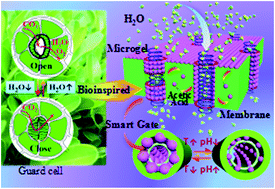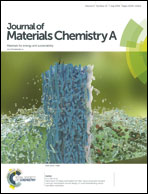Engineering of thermo-/pH-responsive membranes with enhanced gating coefficients, reversible behaviors and self-cleaning performance through acetic acid boosted microgel assembly†
Abstract
Inspired by stomata, a series of single or dual thermo-/pH-responsive smart gating membranes (SGMs) were prepared with in situ assembled stimuli-responsive microgels as gates. Highly cross-linked poly(N-isopropylacrylamide-co-methylacrylic acid) P(NIPAM-co-MAA) microgels underwent in situ surface segregation during the acetic acid-assisted phase inversion process, and they were uniformly decorated on the surface of the membranes and the channels. The hydraulic permeability performance of SGMs was studied within the temperature range of 25–70 °C and a wide pH range (spanning pH 3–11). Investigations revealed that microgels based on different NIPAM/MAA ratios provided different thermo/pH-responsive properties to SGMs. Higher NIPAM/MAA ratios determined the thermo-responsive performance, and higher MAA/NIPAM ratios determined the pH-responsive performance. Moreover, the SGMs with in situ assembled microgels on the surface and channel surface have enhanced gating coefficients, stimuli-reversible behaviours and self-cleaning performance.



 Please wait while we load your content...
Please wait while we load your content...